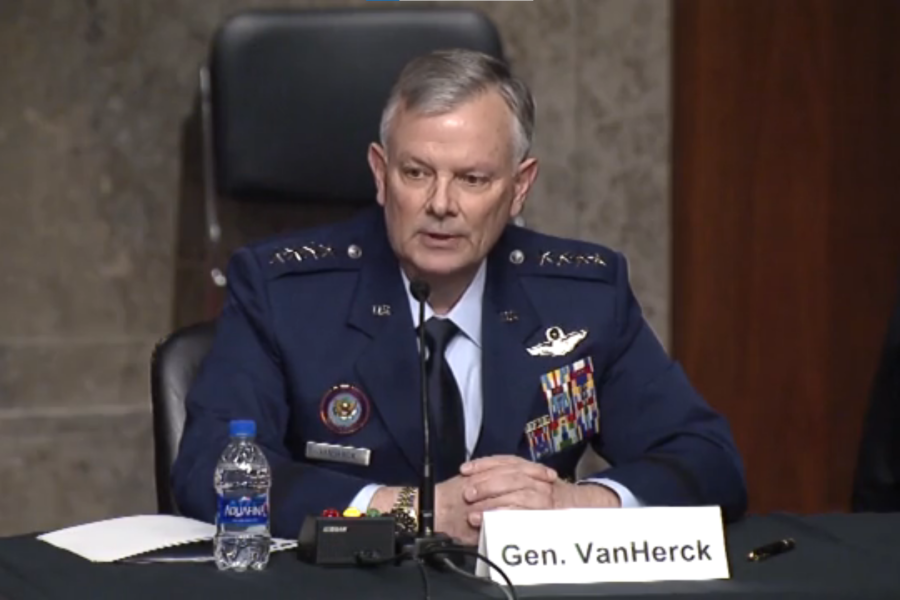Sensors and longer warning time, the ability to deter, and joint all-domain command and control are the top budget priorities for U.S. Northern Command, its commander, Gen. Glen D. VanHerck, told the House Armed Services Committee on April 14.
In a hearing on military activities affecting North and South America, VanHerck was asked what his top three budget priorities are in the fiscal 2022 budget.
“Domain awareness is at the top,” he said, “and that would include over-the-horizon radar capability to see beyond where our legacy systems do today.” Second on his “integrated list” would be undersea surveillance to “ensure we know what’s going on” when underwater craft approach North America, “and then obviously that domain awareness and information” that will “give us options” before having to defeat an attacking system with kinetic weapons.
VanHerck said new sensors will “allow us to see further than we have in the past.” He wants to fuse those data with that generated by existing intelligence, surveillance, and reconnaissance systems, as well as machine learning and artificial intelligence capabilities to assess open-source, social media, and personal traffic. This will “move decision-space left” and buy time to let national leaders engage in “deterrence … and messaging” activity that can stop a kinetic attack before it begins.
Much of the data VanHerck wants in the mix already exists, but is in “stovepipes … where there may be laws or policies that don’t allow us to share that data and information.” He views data and information as “a strategic asset that will enable us to … win” in a future conflict “if we have to, but more importantly, take us further left in the competition to deter and de-escalate in a crisis.”
He said the Pentagon is now talking about “all-domain command and control,” which, “If you put a bow around [it, is] what I’ve been talking about.”
It will be crucial to have policies in place that remove restrictions on critical information sharing before the new JADC2 system is fully developed, to avoid investing in a system that can’t be used, VanHerck said.
“We have to move forward with machine learning and artificial intelligence from a policy perspective and get our arms around this,” he said. “What we can’t do is field capabilities and then wait until the end, and [not] have … the policy and laws that go with it to enable us to support it.” JADC2 needs to be focused on giving leaders from the tactical to national level actionable information, he said. At the operational and strategic level, VanHerck said he, “as an operational commander, could posture forces to create deterrence or the President or the Secretary of Defense could use messaging to create deterrence as well.”
VanHerck also sees “tremendous value in looking at the possibility of an underlayer” of missile defenses to bridge the gap until the next-generation missile defense system arrives circa 2030. It would enhance the ability to defeat incoming missiles “and give us options to create deterrence during competition.”
If the U.S. does create such an “underlayer,” then “it should not be focused on a single threat, such as a ballistic missile. It should focus on everything from small unmanned aerial systems all the way to ballistic missiles, cruise missiles, everything in between. We can’t afford any longer to build stovepiped systems with capabilities for only one threat.”
Asked about defenses against cruise missiles, VanHerck allowed that he’s “trying to get a policy on what must we defend kinetically in our homeland.” The list likely includes “continuity of government, nuclear capabilities, command and control, ability to project power forward, and our defense industrial base.”
Again, though, he wants to be able to deter cruise missiles from being fired, which requires more exquisite knowledge and prioritization of that knowledge by machine systems.
“I don’t want to be shooting cruise missiles down in our homeland,” he said. “Endgame defeat is not where I want to be.” The same will be true of hypersonic missiles, especially since they can strike in half the time of ICBMs, he said.
VanHerck said there’s been a significant uptick of Russian activity in the Arctic, re-activation of a dozen Russian Cold War bases in the region, and a greater need to observe that activity. He supports building more Navy and Coast Guard icebreakers—only one is active, versus dozens in Russian service—and supported a greater operating tempo for U.S. forces in the region.
Asked about difficulties imposed by climate change, VanHerck said it is making Arctic waters more navigable for competitors, while thawing permafrost threatens some U.S. facilities, makes reaching others more difficult, and makes it harder to build new ones.
